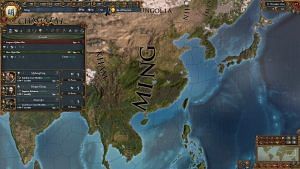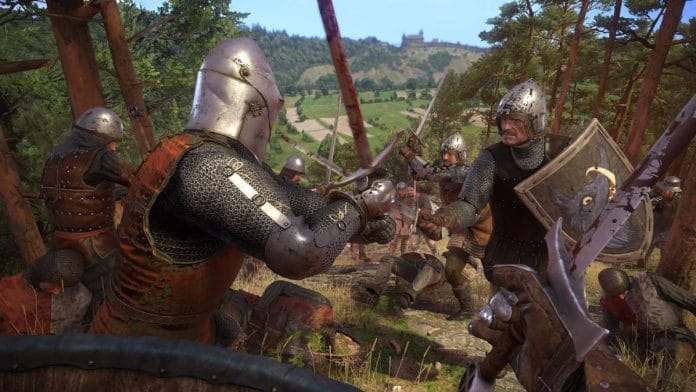I saw the world through the eyes of a man living in 15th-century Bohemia, or present-day Czechia. I entered a great cathedral, gasping at its immaculately painted walls, and its looming ceiling decorated with stars. That’s not why the scene is stuck in my mind: it’s because my video game character was uproariously drunk. Right after entering the cathedral, I had to deliver a sermon on the fiery reformer Jan Hus to an impatient crowd. I can still tell you what Hus believed, and about the peasant rebellion he sparked off. A combination of irreverence and curiosity is how we make history memorable: by experiencing the past. In no particular order, here are some games that thrilled my historical imagination.
Going to war
The game I was just telling you about is called Kingdom Come: Deliverance, played from the perspective of Henry, a blacksmith’s son turned lord’s retainer. Quite early in the game, Henry’s village is attacked by an army. He watches in horror as hundreds of heavily-armed men appear on the horizon, and is powerless to fight them as they ransack and burn his village and kill his friends and family. This isn’t a perspective we see much in India. All too often, wars are depicted in our media as a glorious clash between heroes and villains. In reality, war is brutal and bloody, the result of endless political and diplomatic failures, the consequence of valorising the most violent. And those who fare worst in war are usually the voiceless, the undefended.
It took a while for me to come around to this way of seeing the past. Most of the early video games I played were about violence from the top down, letting you play as kings sending armies at your enemies. Some of my most memorable experiences were with the Total War series, set in various historical time periods—such as ancient Rome, medieval Europe, and pre-Shogunate Japan. You manage a rudimentary economic simulation of your empire, but that’s just to pay for the enormous armies that you command on the battlefield. You prepare infantry units to take the brunt of an enemy advance; you find a hill to position your archers on, or to conceal your cavalry from a decisive blow. There’s something satisfying about dismantling larger armies through superior tactics. But it also shows you how history’s terrible conquerors came to rule sprawling empires: not by commanding enormous hordes, but through smart tactics and manoeuvring.

Much more satisfying (and disturbing) to play was Europa Universalis IV, a deep grand strategy game set in the era of global colonisation. Starting in 1444, it allows you to play as any state in the world—from England to Vijayanagara—up till 1821. It’s primarily an economics simulator, encouraging players to manipulate the flows of trade goods and to ratchet up administrative capacity to extract taxes and manpower for their armies. It allows you to engage in the most ridiculous alternate-history scenarios. I once played as a martial Vijayanagara, conquered most of the Indian subcontinent, and colonised Australia and East Africa. In another campaign, as a multiethnic Mughal Empire, I conquered half of China and then used Hawaii as a forward base for an Asian conquest of the Spanish Americas, led by the Mughal Sons of Heaven and Vijayanagari queens.
I also thoroughly enjoyed Crusader Kings II, by the same developer, which allows you to play as a royal court from 800 to 1400. Crusader Kings II is more focused on the people of the court: their manoeuvrings for power, their lobbying, seductions, rivalries, and quirks. As any medieval patriarch might, you arrange marriages for your children and grandchildren so as to snowball your family’s influence and properties; you also indulge in a spot of murder and war to ensure your schemes work out as planned. Playing in the subcontinent, I was quite thrilled to take the role of a Chola emperor and manoeuvre my relations onto thrones from Andhra Pradesh to Assam (the former retreaded actual Chola history quite well). Crusader Kings II also leans into the absurd at times, allowing you to make your horse a minister, which some players have manipulated to create dynasties of horse rulers and even horse Popes.
But Europa Universalis IV and Crusader Kings II never really encourage you to think about the moral consequences of your actions. They’re all about amoral geopolitics, where history is a linear process resulting from technological advancement or the accumulation of masses of property. You can choose to murder a rival’s children or genocide the indigenous populations of your colonies, and it’s presented through little more than a little text box. You can make armies that eat the food output of entire provinces, and fight wars that kill hundreds of thousands of people. None of this works out to anything more than a few positive or negative modifiers to your bottom line, nor is your state ever seriously challenged by its ability to rule sprawling territory—something every historical ruler struggled with. This is a rather myopic reading of history if you ask me, reducing it only to the cost-benefit analyses of courts and trade companies.
Also read: Vijayanagara was the Indian Renaissance State. It contains memories of older empires
Keeping the peace
The historical gaming genre has experienced a Renaissance in recent years. A generational shift is underway as more young people find studios, absorb influences, and experiment. I particularly enjoy historical city-builders like Anno 1800 and Kingdoms and Castles, which allow players to set up agriculture and manage craft production chains. Wheat growers need to be linked to, say, meat farmers or beer brewers; meat farmers can be linked to canning factories; beer and cured meat can then be exported for profit. It’s not as stressful as it sounds, I promise. It also gave me a deeper appreciation of urbanisation itself. Cities are marvels of organisation and cooperation, and actually experiencing the challenges of urban growth give you a perspective on both medieval and modern urbanism.
While I tend to play India or India-inspired campaigns in games that allow it, I’ll be the first to admit that India is generally pretty absent from historical games. Even in Europa Universalis IV and Crusader Kings II, the focus is on Europe. That’s fair enough: the West’s gaming ecosystem tends to focus on periods and regions that inspire them, and Indian history is not easy to get into. Academic texts can be dense, and politicised misconceptions of history rule the Indian internet. As for Indians themselves, despite huge portions of back-end game development happening in our studios, and our ever-growing gaming market, we’re still in an early stage of our videogame journey. We need more experienced front-end game leads and designers. Recently, an India-based studio was set to remake a beloved title, Prince of Persia: The Sands of Time, but the project was disastrously mismanaged.
As a setting, aside from the odd Bombay level in Hitman 2, or exoticised treasure-hunting locations in Uncharted: The Lost Legacy, India’s videogame footprint is minimal. It doesn’t help that Indians online can be rather easy to offend, as the furore over the inclusion of Hindu gods in the fighting game SMITE shows. We can’t have creative explorations of the past if history is only approached with folded hands. I shudder to imagine the backlash to an Indian Kingdom Come: Deliverance that pokes fun at kings, priests and warriors.
With all this said, there are tremendously exciting games coming out from Indian history lovers abroad, collaborating with Indian historians. I briefly consulted with SemiMyth Entertainment, who are working on A Lion’s Age, a strategy game set in 16th-century India, based around Sher Shah Suri and Humayun that also allows players to get into personal and political entanglements with the vibrant military and courtly labour market of the time. Saverio Spagniole, a mathematics professor at the University of Wisconsin-Madison, has developed Vijayanagara: The Medieval Empires of Deccan India in consultation with historian Aparna Kapadia. Enabling players to take the roles of Vijayanagara or the Bahmani and Delhi Sultanates will allow them to actually experience the complex dynamics of the medieval Deccan.

There’s a long way to go for India in games, but the future is bright. Pune-based Nodding Heads Games received some attention for their action-adventure game Raji: An Ancient Epic. Gamers across the world are happy to explore new cultures and periods, provided that the game is fun. The Assassin’s Creed series has explored everything from Victorian England to Abbasid Baghdad, selling millions of copies. Eastern European countries have encouraged their gaming firms to become global giants: think CD Projekt Red, which burst onto the scene with The Witcher, inspired by dark Slavic mythology. The Witcher series has sold well over 50 million copies.
I hope India’s video game industry will soon be able to bring our rich, dazzling history to global audiences. Until then, I’ll wait for the game that will allow me to explore Vijayanagara and its hubbub of markets and palaces on digital feet, bringing to life the astonishing creativity of that Renaissance city. I’ll dream of city-builder games about medieval Tamil temple urbanism, requiring you to manage ghee supply chains, the import of camphor, and the manufacturing of jewellery. Some day, some day.
Anirudh Kanisetti is a public historian. He is the author of Lords of the Deccan, a new history of medieval South India, and hosts the Echoes of India and Yuddha podcasts. He tweets @AKanisetti. Views are personal.
This article is a part of the ‘Thinking Medieval‘ series that takes a deep dive into India’s medieval culture, politics, and history.
(Edited by Zoya Bhatti)







Crusader Kings III >>> Europa Universalis IV